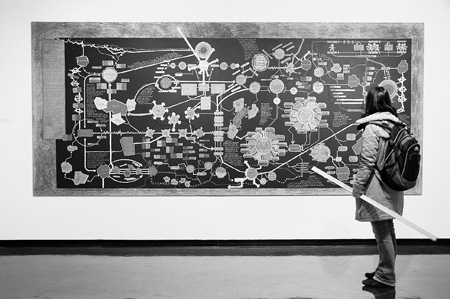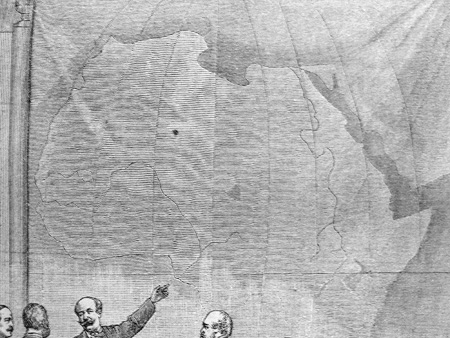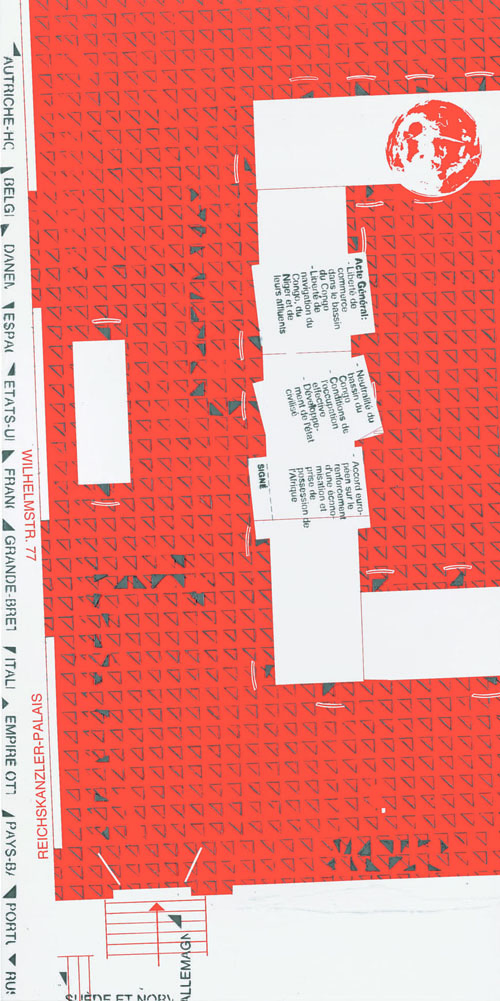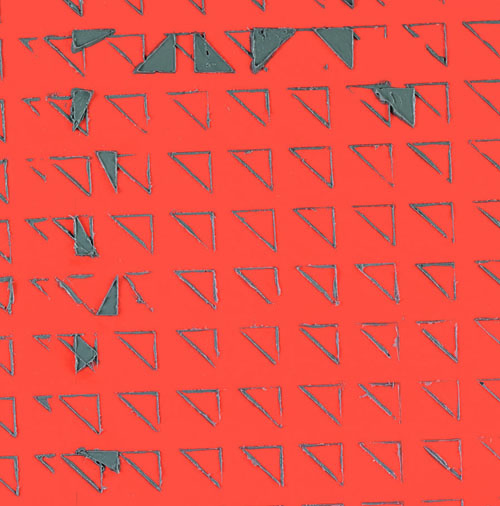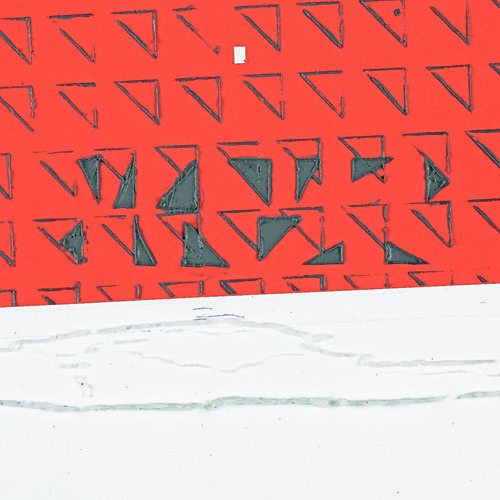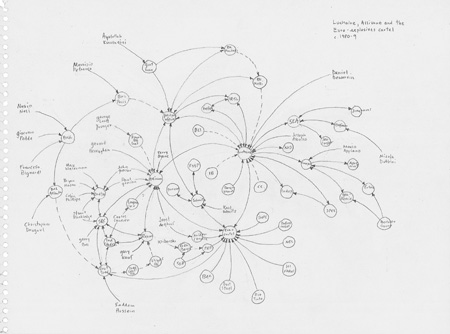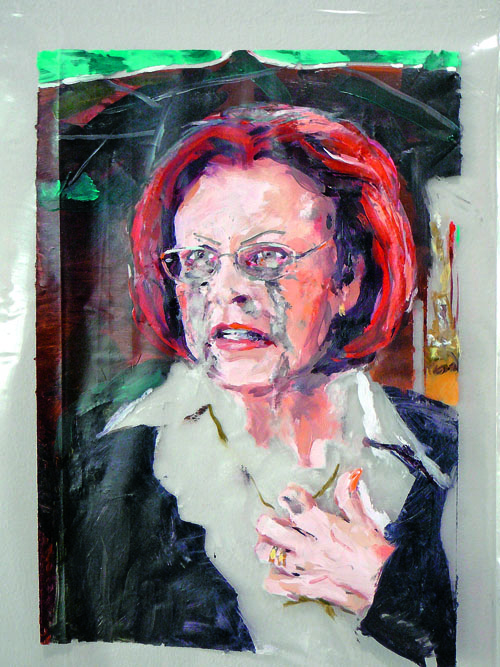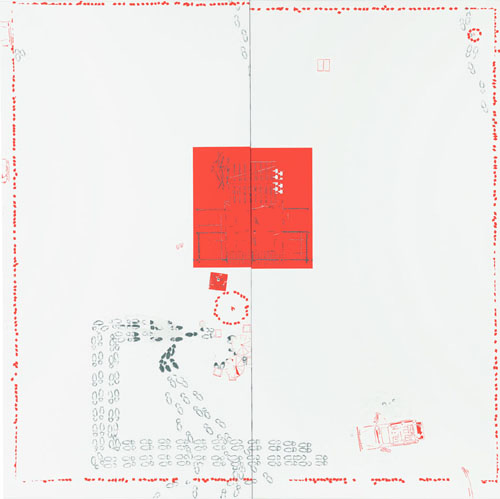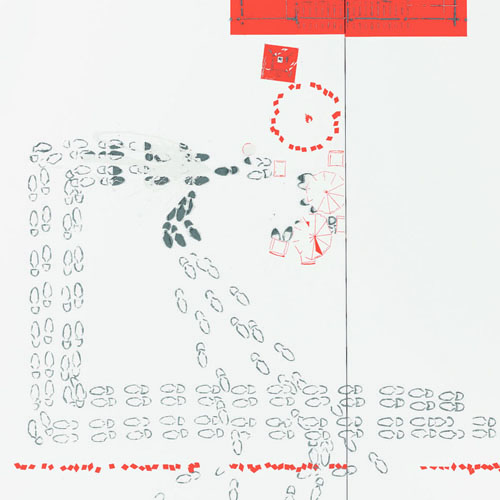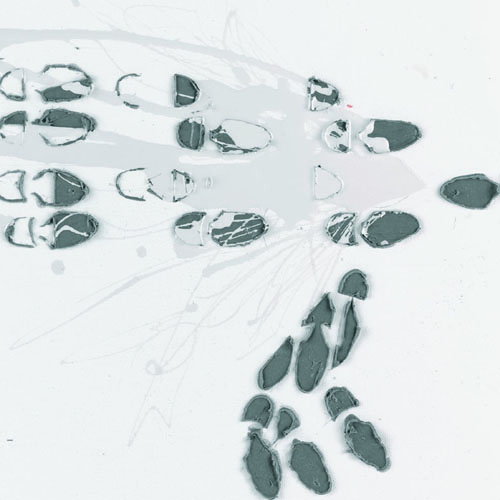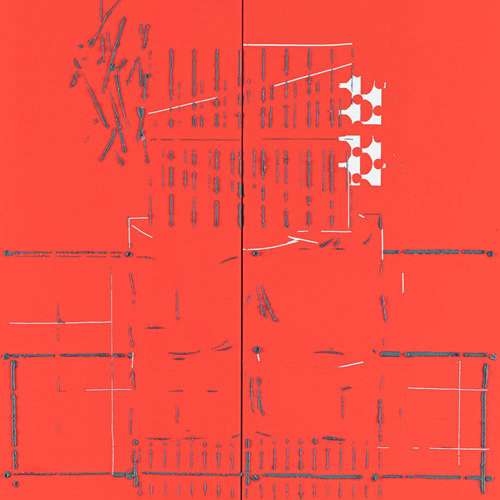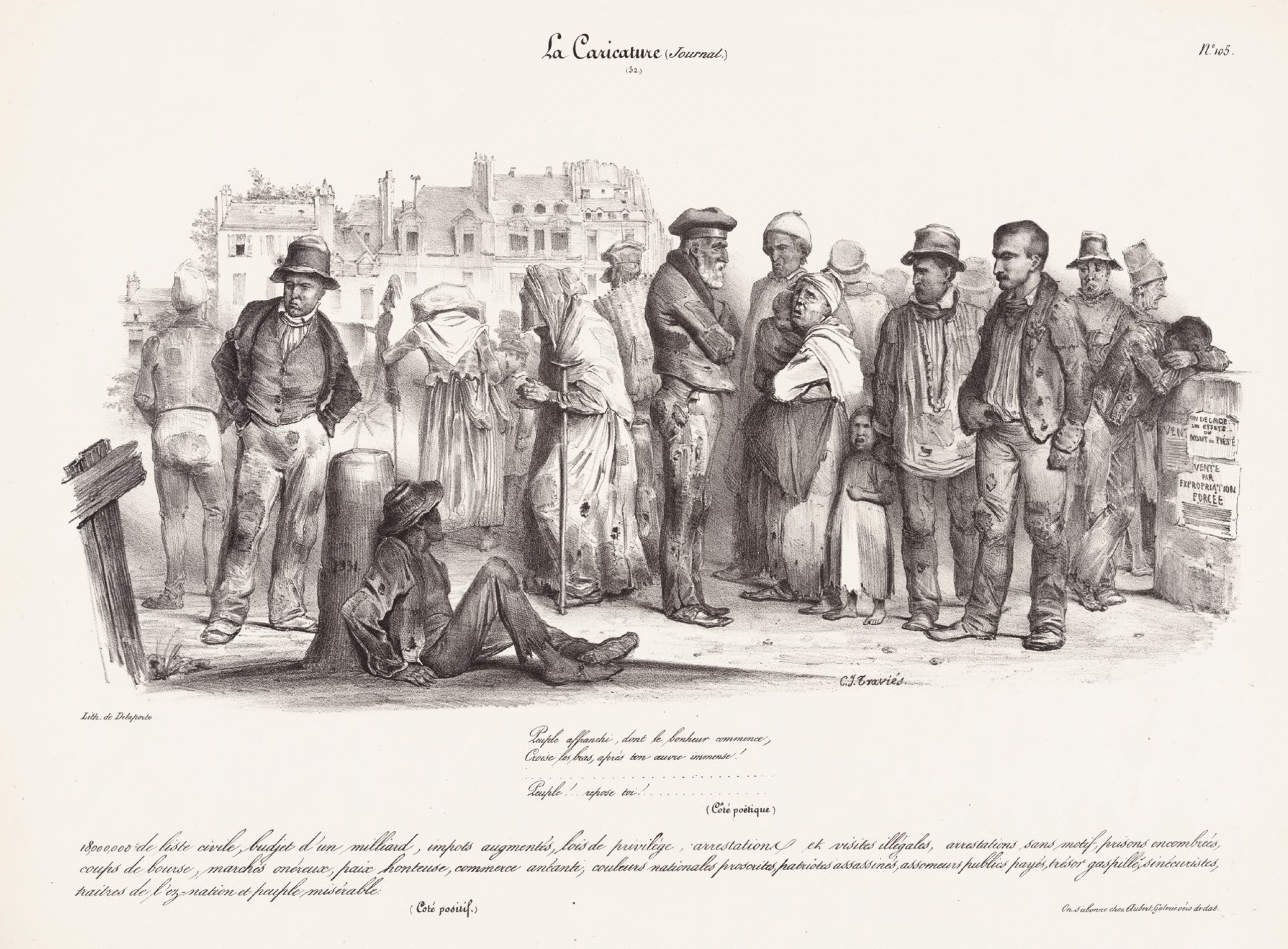Susanne Leeb]
[August 4, 2011
“… The World Was Becoming Numerical.” Informational Graphics and Art in Dierk Schmidt´s “Die Teilung der Erde”
Informational Graphics and Art in Dierk Schmidt’s “Die Teilung der Erde”
The essay is part of the comprehensive project documentation “Dierk Schmidt: The Division of the Earth – Tableaux on the Legal Synopses of the Berlin Africa Conference.” Edited by Lotte Arndt, Clemens Krümmel, Dierk Schmidt, Hemma Schmutz, Diethelm Stoller, Ulf Wuggenig, Cologne 2010.
Dierk Schmidt’s series Teilung der Erde (The Division of the Earth) is defined by a visual paradigm that combines a modernist surface quality and cartographic forms of representation. The works show what they are: the floor plan of Palais Radziwill in Berlin, where the so-called “Africa Conference” took place, a map of the Congo turned 90 degrees, the floor plan of a Namibian ceremonial site or assembly grounds, a kind of unofficial Herero parliament, with footsteps marking out a political ceremony; a diagram explaining the legal steps of the Herero reparations case; and not least a white surface with writing placed upon it: a letter. The figures map, plan, scheme, floor plan all belong to a flat mode of representation that has been paradigmatic for abstract painting ever since modernism. But Schmidt here is addressing not so much artistically formalistic abstraction, but rather fields of knowledge that also use abstract forms of representation, such as statistics and cartography. By way of this visual modus, the works are inscribed in a specific history: the colonization of Africa leading up to the Herero financial reparations suit. The images are thus more a formalistic reflection than a visual political contribution to the question of how to respond to the issue of the German colonial past and its consequences, and of how these consequences can be represented. To that extent, the works surpass questions of knowledge and circle around parameters that have to do with modern abstraction processes in general: How can political events be represented and remembered if they rely on abstract processes and legal negotiations, how can one conceive of events that have perhaps become abstract, due to their having taken place long in the past? How to represent violence if it is structural and results from bureaucratic, administrative acts? Would it not be more important to show the impacts and effects of their function? The following sections explore these questions and their implications by examining the visual modus that Dierk Schmidt has chosen in the framework of a genealogy of cartographic and diagrammatic forms of representation.
Functional Abstraction
When reference is made in art to abstract forms of representation from other realms of knowledge, it is usually with the intention of exploring the impact of abstraction processes, and to engage with the question of what new knowledge, what new means of governmentally, norming, and subjectivity are created through this, and how structural power relations can be visualized.2 As part of these engagements, the informational graphics with which counter-information can be produced or power structures analyzed move into our sights. Several artists have taken up the legacy of Öyvind Fahlström, who took on the surface quality of modernist painting at an early date, by painting political events and power relations as maps. These artists also include Mark Lombardi, who created diagrammatic drawings on financial scandals, the group Bureau d’Études or Ashley Hunt, who explore worldwide financial connections, Alice Creischer and Andreas Siekmann, who update Otto Neurath’s and Gerd Arntz’ atlas of visual statistics, or, rather interrogating formalist modernism, Florian Pumhösl with his Animated Map.3 They all take positions with various implications and artistic interventions on the question of how power structures are represented and how those responsible or simply subjects in general can be located within them. Individual artistic works cannot provide comprehensive power analyses. They can explore certain modes of functioning, sites of intervention, and the effects of functional and systematic abstraction.
Ashely Hunt,” A World Map”. From: “Which We See..”, 2004- (courtesy Betty Rymer Gallery, Chicago)
Bureau d´études de l´Université Tangente, “Governing by Networks I”, Mapping of Borderline Biennial, 2007 (courtesy Abode of Chaos, OrgAn Museum and Thierry)
The fact that diagrammatic representations are especially appropriate here is due to the mutual contingency of modern techniques of government and the specific visuality of diagrams. Dierk Schmidt also engages with this mutual relationship by way of the diagrammatic visual modes in his series Teilung der Erde: as maps, floor plans, and plans, the works join a language of signs that since the end of the eighteenth century, with the emergence of statistics in the framework of economy, engineering, and traffic and then was used in health sciences and demography.4 All new theories of the state argue that the state relies on this form of quantifiable knowledge. Joseph Vogl presents the vision, developed by philosopher Gottfried Wilhelm Leibniz in the 17th century, of a statistical office, a state “intelligence office” that is to undertake a comprehensive gathering of knowledge. To be able to immediately access to this knowledge, Leibniz suggested its systematization using land and sea maps, architectural sketches, and above all the art of bookkeeping, “where everything is narrowed down, made apparent or graspable.”5 Graphs, curves, and tables that combine mathematical calculation and rhetorical evidence thus form a foundation for the modern state.6 They also found use in socialist-enlightenment projects, as in the case of the Vienna Institut für Bildstatistik in the early 20th century, with the purpose of public enlightenment in the realms of the economy, dwelling, nutrition, or hygiene.7
Diagrams and maps are perhaps not modern inventions, but were used as governing technologies and were thus subject to increasing systematization in the form of abstraction and norming. They also played a key role in colonization.8 In addition, maps were linked to statistics, when, for example, in the early 19th century they began to be used to sketch out the circulation of commodities. In turn, statistics itself, as part of administrative technical demographics, served as an instrument of biopolitics and were as part of a so-called “native policy“9 also a fundamental technology of colonization. As Jürgen Zimmerer states in his study about the role of bureaucracy in colonization, “This process of the colonial denial of rights and oppression […] in Namibia took place at a speed that can only be explained by the effectiveness of the bureaucratic administrative state.”10
The increase of administration is accompanied by a new conception of both the subjects to be governed and the governing subjects. Since the 18th century, calculation has been done with multitudes: administrative technical regulation became a form of government. This also brought about a change in the definitions of the subjects of history. In the eighteenth century the era of kings and “great” men as subjects of history comes to an end.11 Hence, in the late 19th century, with the rise of social and historical sciences, the debate is about who or what has taken their place. The answer was: the mass, or the anonymous crowd. The invention of statistics meant that masses of people could be summed up using geometrical signs as a functional or administrative-technical unit. In Dierk Schmidt’s tableaux, they are filled, gray transparently contoured or halved triangles that mark the legal status of those who participated at the Congo conference, and mark excluded actors, who are thus subject to a functional abstraction. This was a component of the formal-technical condition for the division of Africa in the sense of the juridically-based legality of appropriation as well as the then subsequent process of colonization. These symbolic languages themselves have their origin in the aspiration first pursued by economists and engineers to encounter the “mathematicization of the world” – and thus the abstraction of pure numerical information – with more clarity. Since the 18th century, such data has been translated into simpler forms.12
Mutually contingent processes of abstraction and government functions as well as state self-empowerment are treated in Schmidt’s series, which takes up two events of German history: on the one hand the almost complete colonization of Africa, for which the Berlin Africa Conference of 1884/1885 marked a milestone, on the other hand the reparations suit brought by the Herero People’s Reparation Corporation (HPRC) in 2001 for the genocide committed against them and the Nama between 1904 and 1907. The series treats the representability of these (historical) moments – in the framework of the administrative technical as well as juridical conditions that enabled these actions – just as well as the modes of representation that are the expression of these conditions.
Tableaux Graphiques and History Painting
But is it possible to combine representations of history and functional abstraction? Or are images that remain in the language of functional abstraction not in fact accomplices of the processes that they treat, considering that statistical diagrams seem to confirm smooth rationality and objective facticity? The incompatibility of statistics and history is the subject of Jacques Rancière’s The Names of History, in which the philosopher criticizes historiography for being seduced by statistics. In this book, Rancière distills a paradigm shift in the framework of which the diagrammatic visual language of modernity and its current artistic reengagements and revisions can be discussed.
Rancière also refers to the period around 1900, and turns against the “obscure philosopher named Louis Bourdeau” who in 1888 in his book L’Histoire et les historiens (History and the Historians) advanced the thesis of the anonymous crowd in search of a scientific foundation of historiography. Rancière’s objection here is not directed against the conception of a new historical subject, considering that Bourdeau vehemently takes up the cause of democracy in his book. Instead Rancière turns against Bourdeau’s suggestion how this new subject is to be grasped that is in the sense of the new scientificity and objectivity, at best in the “language of numbers and functions. The “science of human facts,” as Bourdeau writes about historiography, “for so long descriptive and literary, is destined to become entirely quantitative. The phenomena of function, the essential objects of study of this science, are in effect measurable by the two modes, the arithmetic and the geometric, of the determination of size. We may, on the one hand, translate size into number, and on the other, we may depict it for the eyes through graphic representation (in diagrams or cartograms) in which we summarize, in striking images that take the place of a universal language, long series of facts whose variations, relations, and laws, appear in the full light of day.”13
To make this paradigm shift, its meaning for art and its questions about the representability of complex events more comprehensible, and to make Rancière’s critique easier to grasp, let us sketch the latter in some more detail. Rancière disputes whether history can be represented at all using the new techniques of visualization: if, as Bourdeau claims, historiography can no longer proceed in a descriptive and literary fashion, but only arithmetically and geometrically, it abolishes itself, according to Rancière. One reason for this is that in depictions of multitudes it becomes impossible to recognize whether at issue are subjects or objects, streams of migration or exported coal. Such representations accordingly lack a key characteristic of historiography, that is, to “intersect names and events with one another.”14 Instead, the representation of quantifiable data is based on a functional abstraction, that increasingly became a technique of government since the invention of statistics in the seventeenth century and its techniques of visualization since ca. 1800.15 In the course of scientification, visualizations, which as quantifiable set theory rely on the ideal of scientific objectivity,16 take hold of newly founded university disciplines, beyond statistics and economics, which in any event are based on calculation. They seize historiography and thus undertake a shift from the narrative to the illustration.
Charles Joseph Minard, Tableaux Graphiques et Cartes Figuratives de M. Minard, 1845-1869
A print from the 19th century demonstrates this shift in an almost paradigmatic way. The “figurative map,” or carte figurative, as its inventor named it, was created by the French engineer Charles Joseph Minard17 in 1869 and shows Napoleon’s Russian campaign from 1812-13. It no longer represents the triumph or suffering of individual great men, it neither evokes emotions, nor does it allow interpersonal relationships to be recognized but illustrates solely relationships of proportion; the decreasing number of troops along the way to and from Moscow, where only 10,000 soldiers survived of an army of 423,000. The print, which in its West-East orientation borrows from cartographic conventions, is compared to a second image showing the temperatures, so that mortality rates and temperatures stand in a causal linkage that is reduced to a single factor. Such abbreviations produce an evidence that Minard justifies in the following way: “The great expansion that today statistics is undergoing makes the necessity evident to mark its results in less rigid, more useful, and to mark a quicker evaluation of possible forms as numbers…”18
One must only recall the images of historical painting – their mode of representation, the heroics and emotional tragedy of the moment represented, their cast of characters – to see why the diagrammatic form entailed a radical break in the visual representation of historical events. While these new means were not at first recognized in the realm of art, since statistic visualizations were developed in other social areas (of knowledge) that had nothing to do with art. But the competition with historiography became apparent quite soon, as shown by a comment by Étienne Jules Marey, the inventor of chronophotography and numerous apparatuses for recording movement. Minard’s map, according to Marey in 1878, would challenge “the pen of the historian with its brutal eloquence.”19 The eloquence rests on the evidence of the representations, an “immediate accessibility” for the eye.20 The tableaux graphiques respond to the demand of statistics and bureaucracy for data that could be grasped at a single glance. Rancière sees this paradigm shift of conventions of representation as a fatal error. For whoever demands that history replace the deceptive language of history with the certainty of mathematics is demanding that it “die painlessly.”
For Rancière, “deceptive” has a positive connotation, and refers to the necessary uncertainty of all knowledge.21 His argument for knowledge and against certainty is so vehement because knowledge is always linked to the question of who and with what means it is produced, while certainty already claims the status of truth. But knowledge, as Rancière continues, could not at all exist without expressive power, without the awareness of various forms of representation and articulation, the possibility of inscription and re-inscription, modes of interpretation and contingencies. He thus turns against the modern dream of a purely factual historiography, “studied up on geography, statistics, and demography” and wanted to protect itself from the “fables of opinion and the twists of hack writers.”22 This precisely would lead to history becoming pure set theory and comparative sociology. Accordingly, Rancière holds up the narrative, as a subject of history, however shaped, to which a certain status, affects and events, and not least responsibility could be attributed. “To distance ourselves from the traditional subjects of history and from the means of verification attached to their visibility is to penetrate a terrain where the very meaning of a subject or an event is shaken, along with the manner in which we may make reference to the first and draw an inference from the second.”23 And once more, in more apodictic terms: “We must name subjects: we must attribute to them states, affections, events.”24 Alongside the possibility of being able to attribute responsibility, at issue here are questions of verification, of witnessing.
With Rancière’s invective, the question is posed of how artistic practices relate to history if they use the very modes of representation that threaten to abolish it. How does Schmidt link subjects with events in his images? How do artistic works approach this modernist paradigm shift to set theory, diagrams, and maps? Do current artistic approaches of cartography begin with “those taxonomies, systems of meaning and signification, through which knowledge is produced?“25 Do Schmidt’s works, in using such symbolic systems, ask about the government technologies and forms of action, which also includes the juridical level? This point becomes relevant if we consider that Schmidt, with his aesthetic constructions, which seek to visualize the legal and administrative technical conditions of the division of Africa as well as the reparations suit, relies on juridical and functional abstractions, whereby he touches on previous series where he explored the representability of an image of history.26
The Cartographic Imaginary
How can history be told when administrative acts have taken the place of subjects? Is this replacement already an effect of bureaucracy, to make decisions to such an extent anonymous that events no longer can be attributed to any subjects? What can Schmidt’s pictures do, if not just reproduce this system? This can be answered if we compare his works with one of the best known reproductions of the Berlin Africa conference.27 The reproduction from the newspaper at the time shows the historical event of the conference in the mode of representation: a room in which the individual agents of history are shown, delegates from thirteen European countries as well as the US. The reproduced engraving shows how the brand new map designed by Heinrich Kiepert defined the furnishings of the room, as was underscored in many newspaper articles of the period. “In the conference hall itself, a large 5-meter-high map of Africa by Kiepert reminds us of the direct purpose that brought together this illustrious assembly.”28 Maps were not only the essential means for illustrating the “purpose” of the conference, that is, to achieve an agreement on the Congo, which was claimed by several powers. It played a key role, due to its symbolic significance for nationalism and patriotism, for it first triggered the demand for colonies.29 Not least the map’s degree of abstraction, taken for the territory itself, created a specific space of action: during the Africa conference, according to the historian Ronald Robinson, “the participants marked out the map, a theoretical exercise on a continent, that up until then did not exist in this readily viewed form. This speculative division cost little on diplomatic paper and no serious fueling of the colonial flames was necessary to activate this process.”30 Such an act of expropriation or appropriation by way of cartography was to be repeated in what would later become Namibia when it came to the question of land division. Several Besitzstandkarten (“property maps”) at the National Archives of Namibia show the almost complete division of the country into zones still valid today, based on an act of appropriation of land that was previously collectively used.31
Die Kongokonferenz in Berlin, Original drawing by Adalbert von Rößler. Üeber Land und Meer, 1885 (detail)
The historical engraving represents an event, the act of division. With its representation of the map of Africa, it suggests the extent of the imagined disposability of a supposedly empty continent that lied at the foundation of the process of colonization. But it does not show that the process of negotiation took months, nor the abstract operations and formal, legal conditions that colonization rested upon, nor does it include other subject positions.32 These abstract processes include the conception of geographic terrain as merely available for negotiation, the fixation of legitimate and exclusion of illegitimate negotiation partners, as well as the declaration of Africa as a terra nullius, which thus stood ready for appropriation and division.
Schmidt’s pictures, in contrast to the engraving, show the political and juridical spaces of negotiation, without the ornamentation of representation. With his floor plans, diagrams, and maps, he remains within the minimalistic mode of the operation of governmental technologies. The spaces, otherwise so different, are linked by the same color scheme: the Reichskanzlerpalais, the site of the so-called Africa Conference, is reduced to a flat, orange-colored surface, like the Congo Basin itself. The ground plan of the ceremonial site is also orange, as well as the floor plan of the shanty with a corrugated tin roof in the middle of it. At this place, a quasi-exterritorial space, each year a sort of unofficial Herero parliament convenes to commemorate the war that the Herero fought as sovereign power, but also as a memorial to the dead of the genocide and post-war rule.33 Members of the Herero Corporation also brought reparations claims against the German government.
With this homogenous color scheme, Schmidt uses a technique common in cartography, where color is used to create an aesthetic and thus thematic link between disparate zones, between continents, languages, time zones, cultures, histories, topographies, and forms of social organization.34 This abstraction of all other possible qualities of the sites and the profiling of a single, one might even say aesthetic side of the bureaucracy that unifies the most various spaces and functionalizes them. In this way, sites that cannot be joined under other categories – ceremonial site and commando house, Reichskanzlei (Palais Radziwill), and the Congo Basin, are marked in the series as politically and juridically linked in relation to the issue of colonialism in Namibia and genocide. In so doing, they are also marked as spaces of negotiation into which acts of resistances are also inscribed.
Dierk Schmidt: Tableau 2, Conférence de Berlin
Dierk Schmidt: (detail1) The ceremonial (ritual) of diplomatic receptions—greetings on the perron, in this case by Bismarck.
Dierk Schmidt: (detail2) “Group photo” of the conference participants in front of the 5-metre high map of Africa, drawn up by Richard Kiepert on the occasion of the conference.
Structures of Power
If we place the visual mode of Schmidt tableaux within a historical framework, we can see how a change of the actors of power is accompanied by a change in forms of representation. If, as art historian and semiotician Louis Marin has shown, the mode of representation found its paradigmatic location in the absolutist royal portrait35 with the play of absence and presence, would diagrammatic representations not be adequate for modern and current modes of domination? Mark Lombardi provided a first attempt to answer this question. Curator Robert Hobbs describes him – surely quite correctly – as someone who tried in his work to redefine the tradition of history painting, in light of other agents of power: “He intended to update history painting in terms of theories of globalism and rhizomic schematizations of power.”#A36 With his drawn links between banks, corporations, and governments, Lombardi remains true to several principles of history painting, even if he argues visually on a structural layer.
Since Lombardi, as he himself said, was interested in the structures and mechanisms, the uses and misuses of power within the global political economy, and chose banks as his object of study,37 his drawings are rather sketches for an (im)possible story. More explicitly than Schmidt, Lombardi places his pictures within a tradition of history painting. As he put it, they had exactly the dimensions, the dramatic element and the monumentality that is associated with battle paintings or the representation of other significant historical events.38 But the means of representing historical financial scandals, however, do not come from the realm of painting, but, like the visual languages used by Schmidt, stand in the tradition of tableaux graphiques or cartes figuratives that economists used to map the flow of commodities. Hobbs mentions both information graphs from Time on the financial scandal around the BCCI scandal, a US bank, as well as train and flight plans from Edward Tufts’ classic of information graphics Envisioning Information(1990) as possible aesthetic models for Lombardi’s measures for structuring and aestheticization – plans that consist of links between nodes in international networks.39 Lombardi thus makes the historical events of the financial scandal to one of the conditions of possibility: the international networking of the banks as a diagrammatic network structure, which he additionally dramatizes and rhythmifies.
Mark Lombardi, “Luchaire, Allivane and the Euro-Explosives Cartel c.1980-9″, 2000 (courtesy of Pierogi)
Different Aesthetics of Administration
Schmidt’s and Lombardi’s undertakings, to produce diagrammatic structures of historical paintings that rely on functional abstractions and structural forms of power, can be related to a specific aesthetic that Benjamin Buchloh called the “aesthetics of administration.”40 Buchloh refers to a number of works of conceptual art to which he attests legalistic techniques in their mode of production. This is clearest in the case of Robert Morris, who in his 1963 work Document (Statement of Aesthetic Withdrawal) denied an image its aesthetic value. Using the principle of the readymade as his point of departure, Morris wanted to understand the artwork as the “ultimate subject of a legal definition and the result of institutional validation“41 and localize it beyond any visuality. Another project to which Buchloh refers is Mel Bochner’s anti-aesthetic 1966 exhibition Working Drawings and Other Visible Things on Paper Not Necessarily Meant to Be Viewed as Art, where the artists Bochner invited only sent in sketches, plans, tables, diagrams, and calculations, that lied about in binders in the form of photocopies, filed away documents of self-administration, usually in tabular form. With “aesthetic of administration,” Buchloh was referring to what he sees as ambivalent adaptation of concept art to the bureaucracy of administration since the 1950s, both in terms of the appearance of the works as well as in the performative acts they undertake. He names as a model Marcel Duchamp, who anticipated the “introduction of legalistic language and an administrative style of the material presentation of the artistic object”42 and thus promoted an erosion of faith in the autonomy of aesthetic experience. It would be well worth discussing the notion of a concept of an aesthetic administration, considering that Buchloh subscribes to Theodor W. Adorno’s interpretation of a “totally administered world” and sees the post war period in these terms, although the question on the relationship of act of administration and subjectivity, as Vogl has shown in his Kalkül und Leidenschaft, stretches much further back than the 1950s and itself created new forms of negotiation. But how do Schmidt’s images address such an aesthetic or inscribe or rewrite it?
Shifting from conceptual art to Schmidt, we realize that Schmidt is precisely not interested in retreating from visibility, or replacing the artistic act with a performative-legalistic one. Not only does the work use a very classical format; what is expressed in the work are forms of visibility, administrative and juridical abstractions that in their functionality as power-structuring element had remained invisible. At issue is visualization and the materialization of abstraction. This becomes not least visible in the way in which letters and shapes are applied to the image surfaces in Schmidt’s series: they seem like a relief, as if pressed through a stencil, but drawing random threads and developing in various forms and densities a respective material rhetoric of its own.
If conceptual art demonstrated that art is a space of power and not a space of taste, Schmidt uses the art institution to explore power structures and spaces of action. We no longer reflect about the conditions of visibility or our own mediacy, but also about which practices and techniques of government are made possible by modern processes of abstraction and representational forms, from the homogenization of spaces as purely functional or the marking of territories in the imaginary space of map projection. To realize that our own visual language has its roots precisely in this modernity as well as in a functional division of fields and disciplines and their respective competencies belongs to the archaeology of modernity that artists and curators have been trying to write for some time.43
Dierk Schmidt: Wieczorek-Zeul le 14 août 2004 à Okakarara.
The question here at issue – whether history and subjects can stand in de-subjectivating mode of statistics and functional abstraction in some kind of relation – goes beyond a reflection on visual language. Rancière proposed linking events with subjects. In Schmidt, we encounter first of all – in the way the images are made – a reduction of the artistic subject behind the specific form of abstraction. In so doing, the images demonstrate that the bureaucracy does not recognize subjects as an authority, for they become the material for negotiation. But within the series there are also fissures: the kinds of abstraction are neither homogenous nor are they presented as single mode of representation. Part of the series is a small painted portrait of Heidemarie Wieczorek-Zeul, very disheveled and cried out, the German Federal Minister for Economic Cooperation and Development. In 2004, Wieczorek-Zeul presented the apology for the genocide that had been lacking for decades, but formulated it in such a way that no possible juridical consequences could be derived from it. The work including the aforementioned letter, in contrast, is almost semi-abstract. This letter was written by Nama chief Hendrik Witbooi to a British governor present at Walfishbai, who themselves eight years earlier had been participants at the Berlin Africa Conference. In the letter, Witbooi expresses his great disappointment about the fact that that the German colonists were no longer behaving according to the agreements that had allowed them to enter the country. It ends with the request to the British governor to remove the Germans from the territory of the Nama. He speaks as a legal subject, a status that the colonialists denied him. Abstract and figurative representation can also be linked to the images of the Oturupa movement, which also takes up a moment of self-assertion of a political subject, and thus a status denied them by the Germans in the process of colonization and then refused by the South African government. On Schmidt’s work, before a view of the building of the unofficial Herero “parliament,” the footsteps of a ceremony are drawn in, a ceremony by which this political authority reconstitutes itself anew in a performative act, thus marking out a space of recognition and law. While the actors are made anonymous, the footsteps symbolize individuals, not multitudes. The markings represent an activity, an assertion and marking of “space” – in both a concrete and an abstract sense, that for the beholders can be understood using the steps. Accordingly, all these primarily white images are opposed to primarily orange ones, with triangles. The work about the suit has also been kept half-abstract. The mode of representation of the series alternates within the framework of abstraction, depending on which subject with what political status takes the place of the person acting. The series thus suspends categories like abstraction or concretion. In the series, those sites are sought out where abstract thought becomes effective – in terms of political power, but also as a form of resistance ore re-appropriation. It is thus about the installation and opening of a space of negotiation that is equally juridical, performative, and aesthetic. That the work as an artistic one thus always also refers to the subjectivity of its producer could be interpreted as disproportionate, in light of the complex subject matter. On the other hand, the position marked as subjective ensures something that Rancière had already called for: again linking subjects to events – in this case – and not the historical ones, but current subjects, which not only includes the producers, but the beholders of the works as well.
Rancière is naturally not suggesting a return to the history of “great men,” but to consider what the transition from the history of events to the history of structure implies.44 He proposes here as a model Fernand Braudel’s The Mediterranean and the Mediterranean World in the Age of Philip II45, for, as Ranciere suggests, Braudel has found a new appropriate subject of history, the Mediterranean, one that cannot be attributed to the geographers, but the historians, “following all the paths along which human activity, making as well as made by the Mediterranean,” and furthermore, die “unity … of a system and network of activities”46, that shapes this space. A thought from this can be applied to the work of Dierk Schmidt: Die Teilung der Erde does not try to create a unified system, but the history of the Berlin Africa Conference still today represents a space created through specific actions. By way of the functional abstraction of images, the various markings of spaces – for example the diagram of the Otrupa ceremony and festivities and the map of the Congo Basin – enter into a relationship with one another, they overlap and are thus placed in a state of antagonism. This is a rather soberly treated view of the claim of the Herero and Nama, as well as the simultaneously sad fatality, for the story of self-determination remains linked to the story of the genocide. The abstract surface of painting with its functional visuality opens a symbolic space of negotiation that due to the historical events and the radically other horizons of memory and experience is based on irreconcilable positions. This incompatibility remains despite a political process of reconciliation. The functional abstraction used here as a visual language does not stand for a governmental technique of structural violence, but refers to the possibility of keeping spaces of negotiation open, without falling into the humanitarian trap of a narrative of “making good.”
Dierk Schmidt: Tableau 11, Oturupa, Okanhandja 2006
Dierk Schmidt: (detail 1) The odangere, a traditional priest, has the Herero-oturupa line up in a marching formation and welcomes them. The Chiefs at okuruuo, the holy fire, are protected by parasols. The oturupa is meant to be depicted as an autonomous organisational form positioning itself against genocidal extermination.
Dierk Schmidt: (detail 2) The greeting ritual includes the odangere, spitting with hallowed water.
Dierk Schmidt: (detail 3) The dabates on issues of the Herero at the commando house here as an “unofficial parliament”.
Notes
1 This is the subtitle of Chapter 7 in: Ian Hacking, The Taming of Chance, Cambridge 1990.
2 For a discussion of abstraction, see Helmut Draxler’s contribution in this volume. I would also like to thank him for productive conversations. On the differentiation of artistic abstraction, see also the special issue “Abstraction,” Texte zur Kunst, no. 69, March 2009; more specifically on its epistemological derivation, see: Aux origines de l’abstraction, 1800-1914, Musée d’Orsay, Paris 2003.
3 On the individual artists, see for example Alice Creischer, Andreas Siekmann, “Politischer Konstruktivismus,” in: Texte zur Kunst, no. 69, March 2009, p. 124-128; Brian Holmes, Cartography of Excess (Bureau d’études, Multiplicity):
https://www.metamute.org/en/node/6243; Ashley Hunt: https://aworldmap.com; Florian Pumhösl, Anmiated Map, Cologne 2007, last accessed on July 15, 2009.
4 Cf. Hacking, The Taming of Chance, on the applications of statistics.
5 See on this Vogl, Kalkül und Leidenschaft; see also Wolfgang Schäffner, “Nicht-Wissen um 1800. Buchführung und Statistik,” in: Poetologien des Wissens, Joseph Vogl (ed.), Munich 1999, p. 123-144, as well as Rüdiger Campe, “Wahrscheinliche Geschichte: Poetologische Kategorie und mathematische Funktion,” in: ibid., p. 209-230.
6 Ibd.
7 See Nader Vossoughian and Otto Neurath, The Language of the Global Polis, Rotterdam 2007.
8 On the example of Latin America see: Walter Mignolo, The Darker Side of Renaissance. Literacy, Territoriality, and Colonization, Ann Arbor 1995.
9 The historian Jürgen Zimmerer terms colonialism “native policy,” making clear the biopolitical dimension of colonialism: “Under native policy, I understand all measures taken by the colonial state to regulate its relationship to the colonized population as well as the VRO on dealing with the white and the African population.” Jürgen Zimmerer, Deutsche Herrschaft über Afrikaner. Staatlicher Machtanspruch und Wirklichkeit im kolonialen Namibia, Munster 2004, p. 1. On colonialism and biopolitics, see also the essays by Christian Geulen, “‘The Final Frontier …’. Heimat, Nation und Kolonie um 1900. Carl Peters”, and Birthe Kundrus, “Von Windhoek nach Nürnberg? Koloniale ‘Mischehenverbote’ und die nationalsozialistische Rassengesetzgebung,” in: Phantasiereiche. Zur Kulturgeschichte es deutschen Kolonialismus, Birthe Kundrus (ed.), Frankfurt / Main 2003, p. 35-55 and p. 110-134.
10 Zimmerer, Deutsche Herrschaft, p. 1.
11 See Werner Busch, Das sentimentalische Bild. Die Krise der Kunst im 18. Jahrhundert und die Geburt der Moderne, Munich 1993.
12 The “inventor” of such visualizations is the Scots economist William Playfair, for example in his book, The Commercial and Political Atlas. Representing, by Means of Stained Copper-Plate Charts, the Progress of the Commerce, Revenues, Expenditure and Debts of England during the Whole of the Eighteenth Century, London 1786. See on Playfair and the consequences: Edward Tufte, The Visual Display of Quantitative Information, Cheshire 2002.
13 Louis Bourdeau, L’Histoire et les historiens, Paris 1888, p. 291ff.; quoted in Jacques Rancière, The Names of History, trans. Hassan Melehy, Minneapolis 1994, p. 5.
14 Jacques Rancière, The Names of History, p. 15
15 See Vogl, Kalkül und Leidenschaft, passim.
16 See the essential part of interpretation in every “objective representation,” Lorraine Daston and Peter Galison, Objectivity, New York 2007; or: Peter Galison and Caroline A. Jones, Picturing Science, Producing Art, London 1998.
17 The complete title “Carte figurative des pertes successives en hommes de l’Armée Française dans la campagne de Russie 1812-13”. See Arthur Robinson: “The Thematic Maps of Charles Joseph Minard,” in: Imago Mundi, no. 21, 1969, p. 95-108.
18 Complete quotation: “La grande extension donnée de nos jours aux recherches statistiques a fait sentir le besoin d’en consigner les résultats sous des formes moins arides, plus utiles et d’une exploration plus rapide que les chiffres […].” Charles Joseph Minard, Des tableaux graphiques et des carte figuratives, Paris 1862, p. 1.
A19 Étienne-Jules Marey, La méthode graphique dans les sciences expérimentales, Paris 1878, p. 73 ( “This map seemed to defy […] the pen of the historian by its brutal eloquence.“).
20 “Le principe dominant qui caractérise mes tableaux graphiques et mes cartes figuratives est de faire apprécier immédiatement par l’oeil, autant que possible, les proportions des résultats numériques.” Minard, Des tableaux graphiques, p. 2.
21 See Rancière, The Names of History, p. 9.
22 Ibid., p. 3.
23 Ibid., p. 2.
24 Ibid., p. 3.
25 Astrid Wege, “Bewegung durch nicht befestigtes Gelände,” in: Mapping a City, Nina Möntmann and Yilmaz Dziewior (eds.), Ostfildern-Ruit 2003, p. 130-137.
26 Dierk Schmidt, SIEV-X. Zu einem Fall von verschärfter Flüchtlingspolitik, Berlin 2006.
27 This illustration could be seen on a bulletin board that stood in the exhibition space of the Universität Lüneburg in a second space presenting material on the Africa conference, among other things.
28 Norddeutsche Allgemeine Zeitung, Abendausgabe, November 15, 1884, p. 1.
29 John Noyes, Colonial Space. Spatiality in the Discourse of German South-West Africa 1884-1915, London 1992, and Russell Berman, Enlightenment or Empire: Colonial Discourse in German Culture, Lincoln 1998.
30 Ronald Robinson, “The Conference in Berlin and the Future of Africa, 1884-1885“, in: Bismarck, Europe, and Africa. The Berlin Africa Conference 1884-1885 and the Onset of Partition, Stig Föster, Walter J. Mommsen, Ronald Robinson (eds.), Oxford 1988, p. 19.
31 See also the contribution by Karen Kappmeyer, “Notes on the cartographic materials”, in this volume, p. XXX-XXX.
32 See on this the international law recognition of colonial possession (and the shift from “settlement colony” to “colony of control” [Beherrschungskolonie]).
33 See the contribution by Usiel Kandjii, in this volume, p. XXX. On the Oturupa ritual: Larissa Förster, “Zwischen Parodie und Subversion. Die Oturupa der Herero und die deutsche Militär Kultur,” in: Eva Leitolf: Rostock Ritz: 23 Fotografien, Cologne 2004.
34 See on the use of color as well as the ideological implications of maps and their forms of projection, Denis Wood and John Fels, The Power of Maps, New York 1992.
35 See Louis Marin, Le portrait du roi, Paris 1981.
36 Robert Hobbs and Mark Lombardi, Global Networks, New York 2003, p. 13.
37 Mark Lombardi, unpublished notes from the 1990s, Mark Lombardi Archive, Pierogy Galerie, Brooklyn, New York: “I am interested in the structure, mechanisms, uses and abuses of power in the global political economy.” Quoted in Hobbs and Lombardi, Global Networks, p. 19.
38 The quote continues as follows: “It has all the weep and expanse, the drama and monumentality one might ordinarily associate with battle paintings or depictions of other significant historical events.“ Mark Lombardi, “Self-interview,” unpublished notes, ca. 1995, Mark Lombardi archives at Pierogi, Brooklyn, New York, quoted in Hobbs, Mark Lombardi, Global Networks, p. 14.
39 See on Hobbs, Mark Lombardi, Global Networks, p. 42 and p. 44f.
A40 Benjamin Buchloh, “Conceptual Art 1962-1969: From the Aesthetics of Administration to the Critique of Institutions,” in: october, no. 55, Winter 1990, p. 105-143.
41 Ibid., p. 119: “Just as the readymade had negated not only figurative representation, authenticity, and authorship while introducing repetition and the series (i.e, the law of industrial production) to replace the studio aesthetic of the handcrafted original, Conceptual Art came to displace even that image of the mass-produced object and its aestheticized forms in Pop Art, replacing an aesthetic of industrial production and consumption with an aesthetic of administration and legal organization and institutional validation.“
42 Ibid., p. 118.
43 See for example Sabeth Buchmann, “Abstrakte Charaktere: Referenz und Formalismus in den Arbeiten von Florian Pumhösl,” in: Texte zur Kunst, no. 69, March 2009, p. 98–111; on the implications of modernism in colonialism, see the forthcoming “In der Wüste der Moderne. Koloniale Planung und danach“, Berlin 2008.
44 Rancière, The Names of History, p. 38.
45 Fernand Braudel, The Mediterranean and the Mediterranean World in the Age of Philip II, trans. Siân Reynolds, Berkeley 1995.
46 Rancière, The Names of History, p. 78-79.
